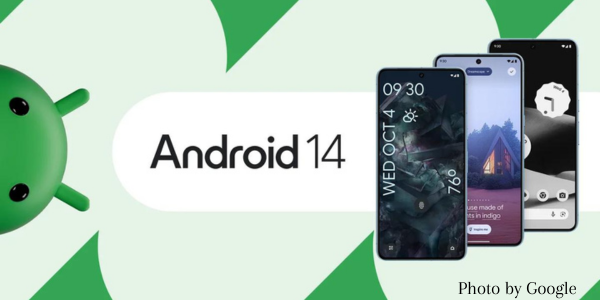The Best Android 14 Features: A Comprehensive Look
Posted by iCoverLover on Oct 30, 2023
Android releases continually evolve to enrich the user experience. Following the significant advancements of Android 13, Android 14 brings many new features and refinements, enhancing device personalisation, data protection, and accessibility.

1. Personalisation and Customisation
Express Yourself: Android 14 introduces an enhanced customisation picker. It allows users to switch between wallpapers swiftly and alter lock screen shortcuts, such as the QR reader or Google Home app.
Lock Screen Templates: You can now choose curated lock screen templates, which adjust according to scenarios. If the weather deteriorates, for instance, your weather widget becomes more pronounced.
Generative AI Wallpapers: First on Pixel 8/8 Pro, these wallpapers use AI-generated text-to-image models, enabling users to craft unique wallpapers with ease.
Monochromatic Theme: For those who appreciate a minimalistic design, Android 14's monochromatic theme offers a stylish and visually calming device appearance.
Improved Camera and Photo Quality: Building on Android 13’s HDR video capabilities, Android 14 introduces Ultra HDR. This ensures your photos capture vibrant colours and stark contrasts, and maintain their original quality.
2. Health, Security and Data
Health Connect: This new built-in feature consolidates all your health and fitness data from various apps into one centralised place, ensuring better privacy and control.
Enhanced Data Protection: Android 14 enhances user control over data sharing, offering insights into how apps use and share your data.
PIN Security: Encouraging a six-digit PIN for better security, Android 14 also removes the need for an 'Enter' confirmation for 6-digit or longer PINs.
3. Accessibility for All
Improved Features for Low-Vision Users: Android 14 introduces a more intuitive magnifier, customisable magnification settings, and nonlinear font scaling for better text readability.
Hearing Aid Support: This update simplifies connections to hearing aids with dedicated settings, ensuring audio routing is more seamless.
Flash Notifications: Designed primarily for those hard of hearing, users can activate screen or camera flashes for incoming notifications.
4. Performance and Utility Enhancements
Improved Battery Life: Google optimises Android 14 for better battery efficiency through tweaks in background task management.
Large Screen Support: With tools and advice for developers, Android 14 ensures apps adapt optimally across different devices, from phones to tablets.
Photo and Video Access: Users can now specify which photos or videos an app can access, enhancing privacy control.
Enhanced Security: Beyond not allowing installations of older app versions, Android 14 also improves biometric login support, elevating device security.
Regional Preferences: Android 14 now supports systemwide regional settings, catering to personal preferences like temperature units or calendar views.
Predictive Back Gestures: For clearer gesture navigation, Android 14 offers predictive back gestures, showing where a back swipe will lead.
Health Connect Integration: Google's Health Connect app, preinstalled on Android 14 devices, provides a centralised platform for health data from various apps.
Refined Share Options: Android 14 aims for a more consistent and intuitive share menu across different devices and apps.
Upgrading to Android 14
For Google Pixel Users: If you're using a Google Pixel phone, particularly from the Pixel 4A 5G model onwards, you're in luck. Google's Pixel devices are always among the first to receive the latest Android updates, ensuring users have immediate access to all the new features and security enhancements.
To upgrade your Pixel device:
- Open the main Settings menu on your phone.
- Navigate to System.
- Proceed to System update. From here, tap on Check for update. If Android 14 is available for your device, you'll be prompted to download and install it.
For Non-Pixel Users: For those using smartphones from other manufacturers, such as Samsung, Sony, Xiaomi, and more, the rollout schedule might differ. Typically, the update to Android 14 for these devices is anticipated to launch later in the year. However, it's worth noting that selected devices from some of these manufacturers might be eligible for the Android 14 beta programme. Being a part of this beta programme allows users to test and experience Android 14 before its official release.
To check if your device is eligible for the beta:
- Visit Google's official Android Beta page.
- Browse through the list of manufacturers and devices to determine eligibility.
- If your device is listed, you can opt to join the beta programme. However, it's essential to exercise caution when installing beta versions. They might contain bugs or unfinished features, potentially causing instability on your main phone. Always ensure you back up essential data before proceeding with a beta installation.
In addition, to stay updated on when Android 14 will be available for your specific device, regularly check your manufacturer's official website, forums, or social media channels. Manufacturers will often announce release schedules or provide insights into the update's availability.
Final Thoughts
Android 14 stands as a testament to Google's unwavering dedication to user-focused innovations. This new chapter in the Android story puts users firmly at the centre, echoing Google’s longstanding mission to make technology more accessible, tailored, and beneficial for everyone. Android 14 doesn't merely introduce a few updates here and there; it presents a holistic evolution of the Android platform. Google has listened, innovated, and refined, ensuring that every user, regardless of their needs, can benefit from a more cohesive, secure, and customisable Android journey. It's an exciting time for Android enthusiasts and casual users alike, as we see the boundaries of what's possible with mobile technology continuously being pushed.
